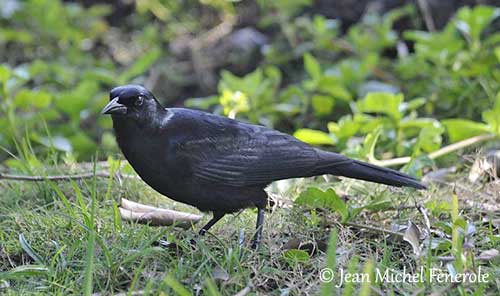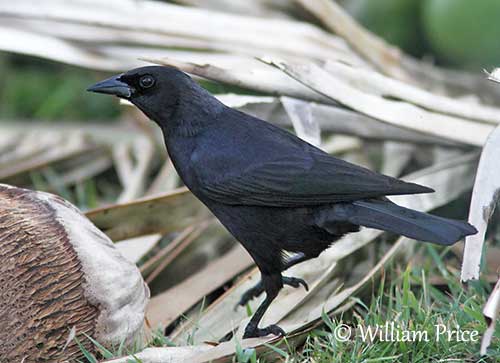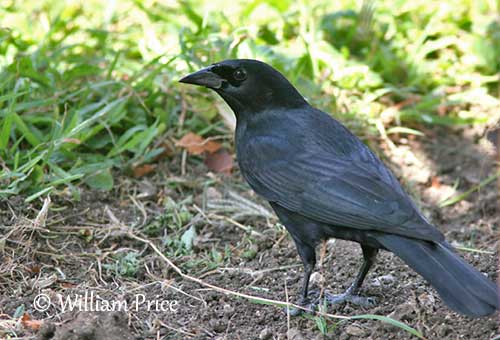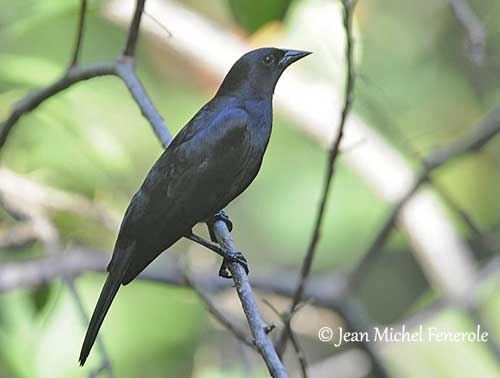
Fr: Quiscale violet
Ang: Cuban Blackbird
All: Kubastärling
Esp: Zanate Cubano
Ita: Ittero di Cuba
Nd: Cubatroepiaal
Sd: kubansk sångtrupial
Photographers:
Jean Michel Fenerole
Photos d’Oiseaux du monde
William Price
PBase-tereksandpiper & Flickr William Price
Text by Nicole Bouglouan
Sources :
HANDBOOK OF THE BIRDS OF THE WORLD Vol 16 by Josep del Hoyo- Andrew Elliot-David Christie – Lynx Edicions – ISBN: 9788496553781
NEW WORLD BLACKBIRDS – THE ICTERIDS by Alvaro Jaramillo and Peter Burke – Helm - ISBN : 0713643331
BIRDS OF THE WEST INDIES – by Herbert Raffaele, Kristin Williams et Tracy Pedersen – Helm – ISBN: 9780713649055
BirdWatching - The birds of Cuba
Cuba Explorer - Birds of Cuba - Endemic and near endemic birds of Cuba
Cuban Blackbird
Ptiloxena atroviolaceus ou Dives atroviolaceus
Passeriformes Order – Icteridae Family
INTRODUCTION:
The Cuban Blackbird is endemic to Cuba. Depending on the authors, this species is classified in the genus Dives or Ptiloxena. The genus Dives includes the mainland species. But the Cuban Blackbird has distinctive skeletal morphology, song and choice of nest-site and its placement in the monotypic genus Ptiloxena is more appropriate.
The Cuban Blackbird is abundant throughout Cuba where it frequents a variety of habitats, including urban parks and gardens. The species is not globally threatened.

DESCRIPTION OF THE BIRD:
Biometrics:
Length: 25-28 cm
Weight: 72-80 g
The Cuban Blackbird is a medium-sized bird with black plumage overall and strong violet iridescence on the upperparts, mostly violet-blue on the crown. The upperwing is glossed blue-green, except the bright violet gloss on lesser and median coverts. The tail is like the flight-feathers and shows blue-green gloss.
The violet gloss of the underparts is stronger on the breast and almost absent on belly.
The black bill is short, thick and blunt-tipped, with curved, not flattened culmen, creating a small hook. The eyes are dark brown. Legs and feet are black.
The female resembles male but her plumage is duller, less iridescent, and she is slightly smaller than male.
The juvenile is much duller, mostly brownish-black, and lacks iridescence.
RANGE:
The Cuban Blackbird is found in Cuba. It is absent from the Isle of Pines or any of the cays.

HABITAT:
The Cuban Blackbird is often seen in urban parks and gardens, gardens in rural areas, cultivated fields, grassland and open forests. It nests usually in strand of palms.
It can be seen in pastures where it takes advantage of insects disturbed by cattle. This species occurs from lowlands to medium elevations.
CALLS AND SONGS: SOUNDS BY XENO-CANTO
The Cuban Blackbird’s most typical call is a loud, repetitive “to-teee” giving the bird its local name “Toti”. We can also hear a clear “tee-to” and a typical slightly nasal note “chup” or “chuk”. It also produces a mewing and series of guttural whistling sounds.
The song is melodious and includes different phrases interspersed with short pauses. The bird repeats a single, sharp note “twee-twee-twee-twee”. Another phrase is a mellow “quee-ahh-whaaaa” and a peculiar nasal “wwwwhhhhhhaaaaaa” fairly similar to a distant braying sheep. It also gives a more complex and warbled song.

BEHAVIOUR IN THE WILD:
The Cuban Blackbird feeds on numerous food items such as insects, fruits, seeds and nectar from flowers. It may take small lizards too.
It forages on the ground, but it also gleans from palms or flowering trees. It takes nectar from flowers and eats ripe bananas.
It often picks insects from cattle like the cowbirds, and eats the insects disturbed by livestock. It also follows the plough for flushed insects.
It feeds on various seeds such as rice, millet, corn, and seeds from wild plant species. It is sometimes considered an agricultural pest.
They often roost in large mixed-species flocks with other Icteridae, especially the Greater Antillean Grackle.
At the beginning of the breeding season, the Cuban Blackbird performs ritual displays while singing. The bird bows forwards, while the tail is fanned and drooped. It also spreads and raises both wings and tail, while head and bill are held upwards.
The Cuban Blackbird is resident in Cuba. They often fly in flocks from their roosts to their feeding areas.

REPRODUCTION OF THIS SPECIES:
The breeding season takes place between April and July. The Cuban Blackbird is solitary nester. Both mates build a cup-shaped nest in the base of a palm frond or in a forked branch in tree. However, it may sometimes use a cavity in tree trunk or in building.
The nest is made with rootlets, hair and feathers, and the cup is lined with softer material, usually plant fibres.
The female lays 3-4 white eggs with grey or brown spots. The incubation lasts about 12 days by both adults. The chicks are fed by their parents. Fledglings are reported between May and August.
PROTECTION / THREATS / STATUS:
The Cuban Blackbird is restricted to Cuba where it is common and widespread. The population size has not been quantified, but is suspected to be stable.
The Cuban Blackbird is currently evaluated as Least Concern.
